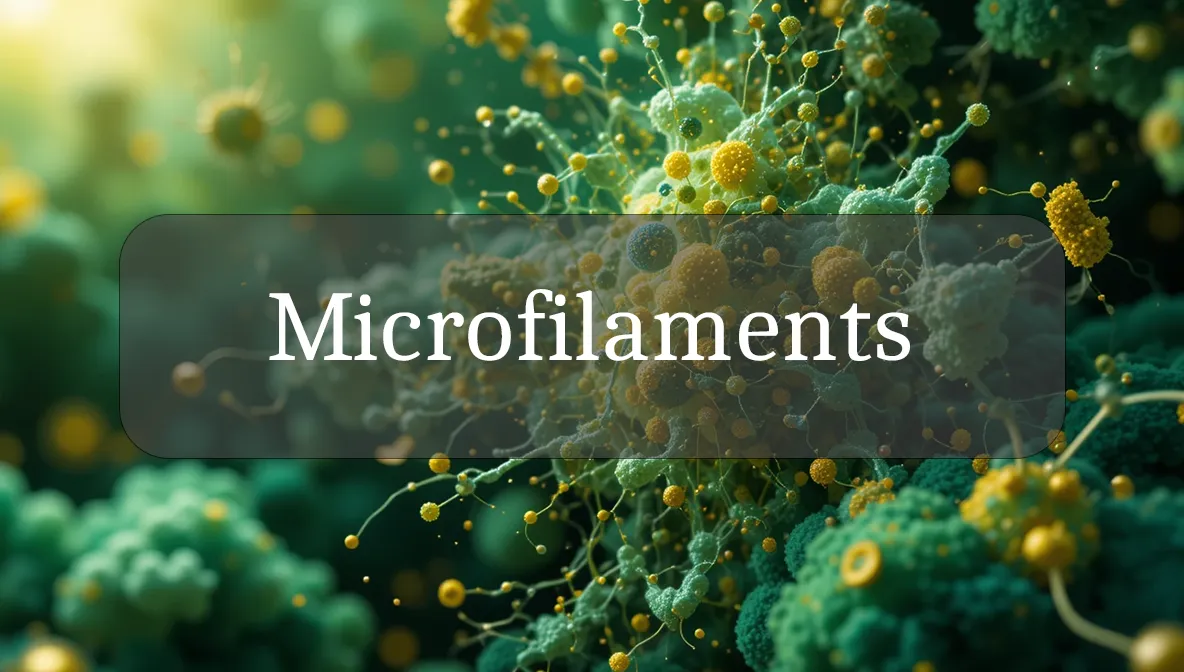Dynamic Threads Powering Your Cell’s Movement
Microfilaments are like the nimble strings inside your cells, orchestrating movement, shape, and flexibility to keep your body thriving. These tiny structures, made of proteins like actin, form a bustling network that helps cells move, divide, and adapt, supporting everything from muscle contractions to wound healing. For health-conscious folks eager to boost vitality, understanding microfilaments can reveal how your cells stay active and resilient. Let’s explore what microfilaments are, why they’re crucial for your wellness, and how to support their role for a healthier you.
Identity and Function
Microfilaments are slender, thread-like cellular structures, or organelles, primarily made of actin proteins, forming a flexible network within cells. Measuring about 7 nanometers thick, they’re the thinnest part of the cytoskeleton, the cell’s internal framework. Found in the cytoplasm (cell’s fluid), microfilaments work like dynamic cables, enabling cells to change shape, move, or divide. They team up with motor proteins like myosin to drive actions like muscle contraction or cell crawling, making them essential for mobility and structure [1].
Biological Role and Health Impact
Microfilaments are the movers and shakers of your cells, with a big impact on your health:
- Cell Movement: They power cell migration, helping immune cells chase germs or skin cells close wounds [2].
- Shape and Support: Microfilaments maintain cell shape, giving tissues like muscles or skin their strength and elasticity [1].
- Cell Division: They form a ring during cell division, ensuring new cells split properly for growth or repair [3].
- Muscle Action: In muscle cells, actin filaments slide with myosin to drive contractions, supporting every move you make [4].
- Health Implications: Faulty microfilaments can lead to issues like impaired wound healing, muscle disorders (e.g., myopathies), or even cancer spread, where rogue cells move too easily [5].
Healthy microfilaments keep your cells agile, your tissues strong, and your body ready for action.
Supporting Health
Microfilaments are produced by your cells, not consumed, but you can nurture their environment to keep them functioning well:
- Balanced Diet: Proteins (e.g., chicken, beans) provide amino acids for actin production, while magnesium supports filament assembly [2].
- Hydration: Water keeps cells fluid, ensuring microfilaments can move and reshape easily [3].
- Sleep and Recovery: Adequate rest (7–8 hours nightly) allows cells to repair and rebuild filament networks, especially in active tissues [4].
- Exercise: Regular activity (e.g., strength training or cardio) stimulates muscle and tissue health, boosting microfilament activity [1].
Signs of Dysfunction
Microfilament problems are rare but can disrupt health:
- Dysfunction Signs:
- Slow wound healing or frequent infections (from impaired immune cell movement) [2].
- Muscle weakness or cramping (linked to actin defects in muscle disorders) [4].
- Brittle skin or poor tissue repair (from weakened cell structure) [3].
- Causes: Genetic mutations, severe protein or magnesium deficiencies, or toxins like heavy metals can disrupt microfilament assembly [5].
- Disease Link: Overactive microfilaments in cancer cells can aid tumor spread, while underactive ones may cause muscle or heart issues [4].
If you notice persistent weakness or slow healing, consult a doctor, as these may signal deeper cellular issues.
Promoting Optimal Function
You can support your microfilaments with practical, everyday habits:
- Eat Protein-Rich Foods: Aim for 0.8–1.2 grams of protein per kg of body weight daily (e.g., fish, lentils) to supply amino acids for actin and other filament proteins [2].
- Include Magnesium-Rich Foods: Nuts, spinach, or bananas provide magnesium, which helps microfilaments form and function [1].
- Boost Antioxidants: Berries, tomatoes, and leafy greens offer cell protectors that shield microfilaments from stress or toxin damage [3].
- Stay Active: Engage in exercise like running, yoga, or weightlifting (150 minutes weekly) to stimulate muscle contractions and cell movement, keeping microfilaments sharp [4].
- Limit Toxins: Avoid heavy metals (e.g., mercury in contaminated fish) or harsh chemicals, which can disrupt filament networks—use water filters if needed [5].
- Prioritize Sleep: Get 7–8 hours of rest to allow cells to rebuild microfilaments, especially in muscles and skin [2].
No specific intake exists for microfilaments, as your cells produce them based on need, but a nutrient-rich lifestyle keeps them dynamic.
Safety and Stressors
Microfilaments are safe as natural cell components, but certain factors can stress them:
- Stressors:
- Nutrient Deficiencies: Lack of protein or magnesium can impair filament production, weakening cell movement [3].
- Toxins: Heavy metals (e.g., lead) or drugs like cytochalasins (used in research) can disrupt actin filaments, harming cell function [5].
- Chronic Stress: High stress or poor sleep can slow cell repair, indirectly affecting microfilament activity [4].
- Safety Considerations:
- Genetic Conditions: Rare disorders like actin-related myopathies require medical care, not dietary fixes [3].
- Environmental Toxins: Test well water for heavy metals and avoid harsh chemicals to protect cellular health [5].
- Overuse Injuries: Excessive exercise without recovery can strain muscle filaments, so balance activity with rest [2].
- Who’s at Risk? Those with poor diets, genetic conditions, or toxin exposure may face higher risks of microfilament issues.
Fun Fact
Microfilaments are like cellular acrobats! Their ability to twist, slide, and reshape lets cells “crawl” like tiny gymnasts, helping your immune system chase invaders or your skin heal a scrape [1]!
Citations
- Alberts, B., et al. (2014). Molecular Biology of the Cell. Garland Science.
- National Library of Medicine. (2022). Cytoskeleton and Cell Movement.
- Mayo Clinic. (2024). Muscle and Skin Health.
- National Institute of Neurological Disorders and Stroke. (2023). Muscle Disorders and Cytoskeleton.
- Centers for Disease Control and Prevention (CDC). (2023). Environmental Toxins and Cellular Health.

